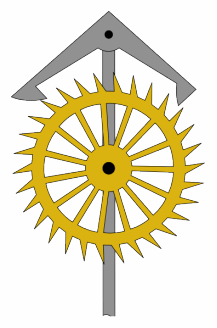Maha is not about
you. It is not about the world.
It is about melding your mind to the
world.
/Gremerdin the
speaker
The pictogram Maha Language of the Elvenspring druids is described in the Forbidden Lands RPG. Players may encounter it as a puzzle in the adventure site Pelagia of the campaign Raven's Purge. What is presented there is pretty limited due to practical reasons. In my first drafts of the game I had the ambition to use the Maha language as a foundation for druid magic and to invite players and game masters to add to the language to see were we would end up. Since some interest was aired in the game forums, I here present my initial thoughts on the language and its structure. Note that this is an unpublished draft and not official in any sense, but please lets discuss what you think!
Picture by Niklas Brandt. These are just examples of signs, not the complete Thesaurus.
Maha Language and Druid Magic
According to myth, Maha is the creation language of the god Clay.
It is used by elves and elvenspring druids. The signs are often
written on small clay tablets, that are burnt and combined when used.
The tablets regularly have a hole drilled in the upper right corner,
showing their orientation. Druids often carry their tablets on a
string through the holes.
The Basics
* Maha is a holy, incomplete pictogram language. It is
traditionally used to create statements that describe and affect
aspects of the world, magically enforcing the statements or making
them come true.
* Maha is a written language of symbols. There is no specific
spoken language connected to it.
* Maha is normally not taught. Learners are supposed to gain
insight by personal interpretation of statements.
* Maha signs are pictograms. Statements are formed by arranging
secondary signs around primary signs.
* A mirrored sign means its opposite. For instance signs for
”white” and ”black” mirror each other. Symmetrical signs have
no opposites.
* Maha signs are seldom complex or abstract and never decorated.
Brevity, simplicity and clarity traditionally means more power and
are the signs of a master.
* Individuals and places might be given unique signs, unless their
names have a meaning that may be written as a statement.
* A laid down Maha statement may normally be interpreted in
several ways over time. ”The most convincing sign” is usually
accepted as true, being the interpretation chosen by the majority of
respected interpreters. An already placed Maha statement may change
meaning as new, more convincing interpretations come about. It is
believed that this also changes the effect of the statement on the
world.
Structure of Maha statements
The primary sign (1) is mandatory. It is traditionally marked with
a drop of the writer's own blood as a tribute to Clay. Druids often carry a small lancet for this purpose. Less
convincing, the primary sign might be marked by having its edges blackened.
Secondary signs (2-5) are added as needed. Their position in
relation to the primary sign determins their meaning. There may be
more than one secondary sign in each position. Additional ones are
added further from the primary signs, and certain schools make a
point of the distance to the primary sign. A shorter statement is
however always preferred. Statements may be added in sequence after
each other to make longer sentences. The more traditional way is
however to arrange statements in groups, leaving more room for
interpretation.
General key:
1 = Noun
2 = verb
3 = adjective / adverb
4 = grammatical form (like plural or genetiv or imperative mode)
5 = numbers and operators (and / or / if – then / not etc)
The same sign changes meaning when it is placed in different
positions. For instance these are all the same Maha sign:
Fire
(1)
Burning (2)
Hot (3)
Imperative form (4)
Melded with (5)
Everyday use of Maha signs
Maha signs are often used to reveal information or wisdom in
druidical holy places. Oracles might for instance offer a Maha
statement. It is up to the reader to understand, and if the reader
doesn't do so, he is considered not to be ready for the statement.
Druids often use Maha signs for meditation and prayer, alone or in
group placing Maha statements, contemplating on the shifting meanings
and investigating interpretative changes when secondary signs are
shifted.
Magical use of Maha signs
(I took some out here – if we were to use Maha in magic we would need to gamify)
Druids may use the Maha language for magic. Depending on skill,
the druid may carry a limited number of signs for this purpose. The
limitation doesn't depend on weight or space of the signs, but
instead on the mental capacity of the user – how many he ”knows”
and is able to focus on, i.e. connected to skill. The carried signs
may over time be exchanged for others, but this normally takes a few
days.
The basic function of Maha magic is that what is stated becomes
true in reality, subject to the skill level of the druid. The effect
is also subject to the interpretation by the majority of readers
around (in practice, the druid player may place a statement and the
other players get to interpret. Majority decides effect).
Maha signs used for magic should be made by the user. Statements
are activated by placing a drop of the druid's blood on the primary
sign.






.jpg)
















